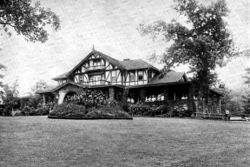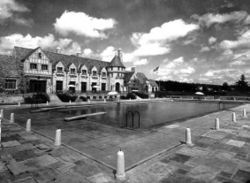Country Club of Birmingham: Difference between revisions
(New page: {{Locate | lat= 33.49610 |lon=-86.76710 |type=h|zoom=15}} The '''Country Club of Birmingham''' is a golf and country club located on 292 acres in a section of Shades Valley drained by ...) |
No edit summary |
||
| Line 3: | Line 3: | ||
==North Birmingham== | ==North Birmingham== | ||
The Country Club of Birmingham was founded | The Country Club of Birmingham was founded at [[North Birmingham Park]] near the terminus of the [[North Birmingham Streetcar]] line on [[September 26]], [[1898]]. Its 77 members, led by president [[Henry Milner]], created it as a driving course for their horse-drawn buggies. Later it expanded to accommodate tennis, golfing, baseball, bowling and bicycling. | ||
A one-story clubhouse was constructed to serve as a dining hall and ballroom, with smaller parlors and changing rooms. The first crude golf links was laid out by [[Robert Baugh | A one-story clubhouse was constructed to serve as a dining hall and ballroom, with smaller parlors and changing rooms. The first crude golf links in the city was laid out by [[Robert Baugh]] with 9 tin-cans sunk into small scraped-down "greens" in an unimproved half-acre meadow adjoining the country club. The then-separate '''Birmingham Golf Club''' course opened for play on [[April 1]], [[1899]]. Later that month Baugh demonstrated the novel game for fellow club members (he shot a 58) and can be credited with introducing the pastime to [[Birmingham]]. | ||
The club's property in North Birmingham was sold to [[Dimmick Pipe]] in [[1900]]. In [[1903]] the Country Club and Golf Club merged into the present combined organization. | |||
==Lakeview== | ==Lakeview== | ||
In [[1900]] the club moved to the site of the former [[Lakeview Park]] and [[Southern Female Institute]], anchoring the end of the [[Lakeview Streetcar]] line. Club pro [[Nick Thompson]] laid out a new 9-hole course on the hilly terrain. Six | [[Image:Bham Country Club Lakeview.jpg|right|250px|The Clubhouse in Lakeview in 1908]] | ||
In [[1900]] the club moved to the site of the former [[Lakeview Park]] and [[Southern Female Institute]], anchoring the end of the [[Lakeview Streetcar]] line. Club pro [[Nick Thompson]] laid out a new 9-hole course on the hilly terrain. Six years later he completed a short front 9 to extend the course to a full 18 holes, now featuring grass instead of sand on the greens. The club members instituted an annual golf tournament and several members rose to prominence in the [[Alabama Golf Association]]. The Women's Southern Golf Association held its [[1915 WSGA tournament|1915 tournament]] at the club. In [[1923]] female members of the Birmingham Country Club founded their own tournament. | |||
The club's much-larger clubhouse at Lakeview was designed in a rustic arts and crafts style by [[Miller & Martin]]. The low-slung building's deep verandahs shaded numerous elaborate parlors and guest rooms. Notable guests at the club included former president Theodore Roosevelt and former vice president Charles Fairbanks. | The club's much-larger clubhouse at Lakeview was designed in a rustic arts and crafts style by [[Miller & Martin]]. It was opened on [[April 7]], [[1904]]. The low-slung building's deep verandahs shaded numerous elaborate parlors and guest rooms. Notable guests at the club included former president Theodore Roosevelt and former vice president Charles Fairbanks. | ||
==Shades Valley== | ==Shades Valley== | ||
[[Image:Bham Country Club.jpg|right|250px|The Clubhouse in Shades Valley. {{BPL permission caption|http://bplonline.cdmhost.com/u?/p4017coll6,1345}}]] | |||
In [[1926]] the club sold its Lakeview course to the city of [[Birmingham]] (which opened it to the public, now the [[Highland Park Golf Course]]). | In [[1926]] the club sold its Lakeview course to the city of [[Birmingham]] (which opened it to the public, now the [[Highland Park Golf Course]]). | ||
| Line 37: | Line 41: | ||
==External links== | ==External links== | ||
* [http://ccbham.org/ Country Club of Birmingham] website | * [http://ccbham.org/ Country Club of Birmingham] website | ||
* [http://www.jdweeks.com/nobham-town.html North Birmingham] website by J. D. Weeks | |||
[[Category:Country clubs]] | [[Category:Country clubs]] | ||
| Line 42: | Line 47: | ||
[[Category:1898 buildings]] | [[Category:1898 buildings]] | ||
[[Category:North Birmingham]] | [[Category:North Birmingham]] | ||
[[Category: | [[Category:1904 buildings]] | ||
[[Category:Miller and Martin buildings]] | [[Category:Miller and Martin buildings]] | ||
[[Category:Lakeview]] | [[Category:Lakeview]] | ||
Revision as of 00:19, 6 April 2009
The Country Club of Birmingham is a golf and country club located on 292 acres in a section of Shades Valley drained by Watkins Brook in Mountain Brook. Established in North Birmingham in 1898, the club has moved twice since its foundation. The current club, which opened in 1926, features two 18-hole golf courses designed by Donald J. Ross and a Tudor-style clubhouse designed by Warren, Knight, and Davis.
North Birmingham
The Country Club of Birmingham was founded at North Birmingham Park near the terminus of the North Birmingham Streetcar line on September 26, 1898. Its 77 members, led by president Henry Milner, created it as a driving course for their horse-drawn buggies. Later it expanded to accommodate tennis, golfing, baseball, bowling and bicycling.
A one-story clubhouse was constructed to serve as a dining hall and ballroom, with smaller parlors and changing rooms. The first crude golf links in the city was laid out by Robert Baugh with 9 tin-cans sunk into small scraped-down "greens" in an unimproved half-acre meadow adjoining the country club. The then-separate Birmingham Golf Club course opened for play on April 1, 1899. Later that month Baugh demonstrated the novel game for fellow club members (he shot a 58) and can be credited with introducing the pastime to Birmingham.
The club's property in North Birmingham was sold to Dimmick Pipe in 1900. In 1903 the Country Club and Golf Club merged into the present combined organization.
Lakeview
In 1900 the club moved to the site of the former Lakeview Park and Southern Female Institute, anchoring the end of the Lakeview Streetcar line. Club pro Nick Thompson laid out a new 9-hole course on the hilly terrain. Six years later he completed a short front 9 to extend the course to a full 18 holes, now featuring grass instead of sand on the greens. The club members instituted an annual golf tournament and several members rose to prominence in the Alabama Golf Association. The Women's Southern Golf Association held its 1915 tournament at the club. In 1923 female members of the Birmingham Country Club founded their own tournament.
The club's much-larger clubhouse at Lakeview was designed in a rustic arts and crafts style by Miller & Martin. It was opened on April 7, 1904. The low-slung building's deep verandahs shaded numerous elaborate parlors and guest rooms. Notable guests at the club included former president Theodore Roosevelt and former vice president Charles Fairbanks.
Shades Valley
In 1926 the club sold its Lakeview course to the city of Birmingham (which opened it to the public, now the Highland Park Golf Course).
The Country Club moved to a 292-acre parcel of former farm land on either side of Watkins Brook. Noted designer Donald J. Ross was commissioned to create two high-quality golf courses on the property. A new clubhouse, designed by Warren, Knight and Davis, opened in 1927 facing the expansive swimming pool, the terrace of which commanded a sweeping view of both courses.
In 1976 the clubhouse was used for scenes in the feature film Stay Hungry.
Courses
- West Course: 6,779 yards, par 71.
- East Course: 6,016 yards, par 70
Presidents
- 1898-1901: Henry Milner
- 1901-: Robert Baugh
- 1917-1919: Robert Jemison, Jr
- 1919-: Charles DeBardeleben
- 1939-: Charles DeBardeleben, Jr
- 1947-: Prince DeBardeleben
References
- Satterfield, Carolyn Green (1999) The Country Club of Birmingham: Centennial History. Birmingham, Alabama: The Country Club
- Satterfield, Carolyn Green (March 16, 2009) "Country Club of Birmingham." Encyclopedia of Alabama - accessed April 5, 2009
External links
- Country Club of Birmingham website
- North Birmingham website by J. D. Weeks

